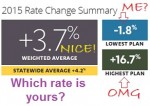However, I still don’t understand why the costs for services for Southern California Kaiser members are so much lower than prices for Northern California members. Does Kaiser just have more members in Southern California to spread the fixed costs of supplying the services over? Kaiser charges 29% more for a colonoscopy in Northern California than Southern California. Are more people getting colonoscopies in Southern California so the volumes of patients help drive down the costs?











